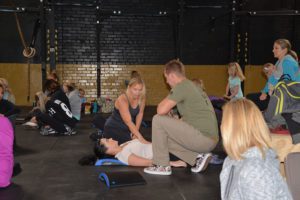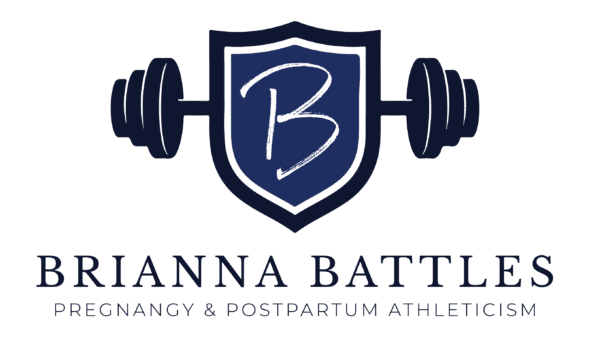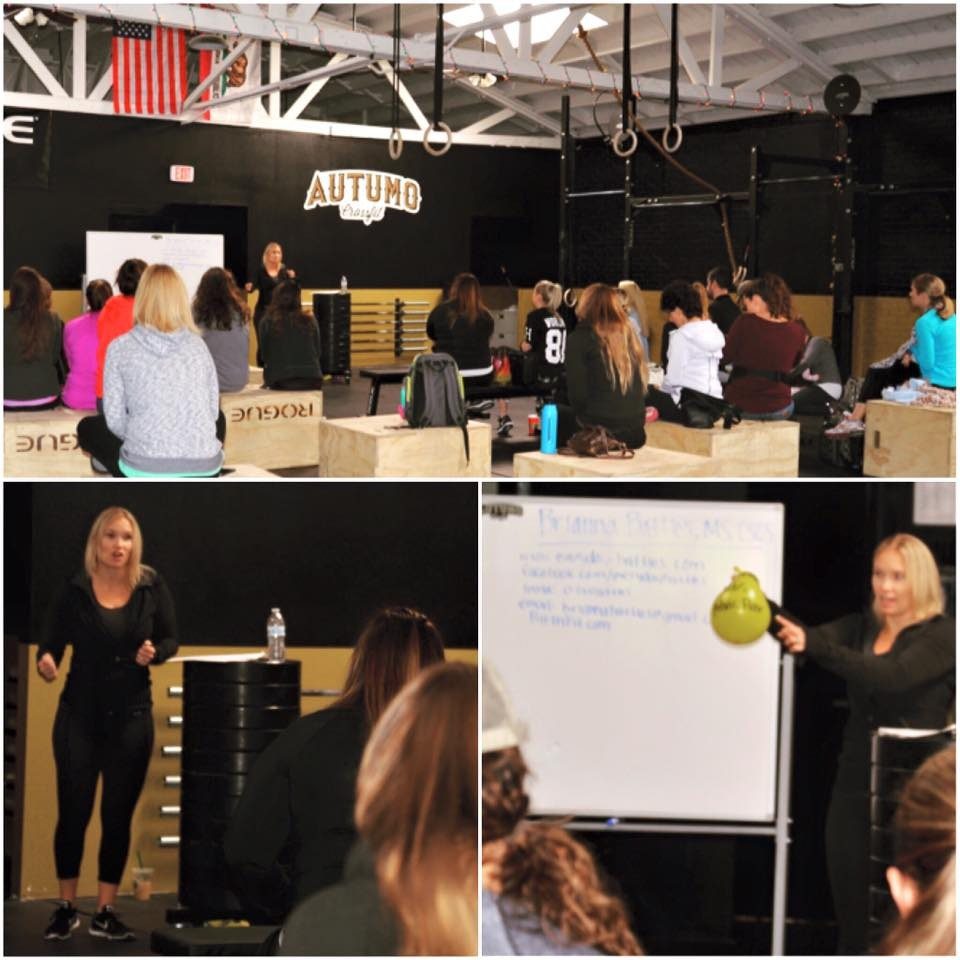 I gave a 2 hour seminar on women’s health and fitness, with an emphasis on pre and postnatal health. This post is for those who missed it or a summary for those who want a mini, ok, maybe not mini, recap on the event and the info in general. A lot of the information can seem overwhelming, especially because the crowd I was talking to was relatively diverse….I tried to connect in a way that (most?) could understand and resonate with. At the end I was given some pretty positive feedback- yes, lucky for me I had a friendly crowd- from a variety of people in attendance. Male, female, pregnant, postpartum and not even considering pregnancy, the information was applicable. Each paragraph summarizes the points that all women and coaches need to consider in order to have well rounded health, fitness and function.
I gave a 2 hour seminar on women’s health and fitness, with an emphasis on pre and postnatal health. This post is for those who missed it or a summary for those who want a mini, ok, maybe not mini, recap on the event and the info in general. A lot of the information can seem overwhelming, especially because the crowd I was talking to was relatively diverse….I tried to connect in a way that (most?) could understand and resonate with. At the end I was given some pretty positive feedback- yes, lucky for me I had a friendly crowd- from a variety of people in attendance. Male, female, pregnant, postpartum and not even considering pregnancy, the information was applicable. Each paragraph summarizes the points that all women and coaches need to consider in order to have well rounded health, fitness and function.
There’s a significant problem in the fitness world, especially for women, and is magnified when/if women choose to have a baby. The problem is the desperate measures women are taking, and being encouraged to take, to attain a certain size or shape. We are surrounded by quick fix “solutions” to lose weight, diet, detox, get in shape, get their body back, etc. Our problems can’t be solved in 28 days, or by wrapping, or by crunching our way to a flat stomach again. As coaches, athletes and empowered women, we need to take a stand and learn to cultivate a habit based lifestyle, a moderate approach to getting stronger, recovering well, allowing time, practicality, moderation and dialed in movement pattern to attain health and fitness. Are you part of the solution?
 Pregnancy is temporary, postpartum is forever. Pregnant women are constantly told to listen to their body. This is great, but only to an extent. They also need guidance that will set them up to heal well in their postpartum chapter and beyond. During pregnancy, just because you CAN do something, doesn’t mean you SHOULD. In order to encourage exercise, we need to encourage the big picture…not only can exercising during pregnancy be beneficial to the mom and baby, but it can set you up for a healthier recovery, but ONLY if the system, the woman as a whole, is addressed. This is where women need to be their own advocate and coaches/trainers need to pay close attention. We must measure risk/reward in terms of exercise/activity choice, but (and here’s the tricky part), meet them where they are. I hate telling runners not to run, but if they’re leaking, have pain, pulling sensations, etc, it’s time to stop. This seems obvious. But what about the pregnant women who are “listening to their body?” Well, they can listen, but it’s my job and yours to at least be informed of risk/reward. Would I suggest women run and sprint until the end of their pregnancy? No. Do some women do it and are ok? Very few. Once again, just because we CAN doesn’t mean we should if we are considering risk reward of pelvic floor health and function of our system as a whole in the postpartum chapter. Another example: lifting heavy. Can we do this? Yes, but how heavy? Do we need to push it to the point of risking pelvic floor dysfunction from excess pressure on the pelvic floor and breath holding, which aggravates a diastaiss? Yes we can lift, and we can lift heavy, as long as a strategy is in place (don’t hold your breath!) to secure the core/pelvic floor without creating imbalanced pressure, oh yeah, and you’re still carrying a baby in there! Think big picture. This is a fantastic resource, based on evidence surrounding fitness and pregnancy.
Pregnancy is temporary, postpartum is forever. Pregnant women are constantly told to listen to their body. This is great, but only to an extent. They also need guidance that will set them up to heal well in their postpartum chapter and beyond. During pregnancy, just because you CAN do something, doesn’t mean you SHOULD. In order to encourage exercise, we need to encourage the big picture…not only can exercising during pregnancy be beneficial to the mom and baby, but it can set you up for a healthier recovery, but ONLY if the system, the woman as a whole, is addressed. This is where women need to be their own advocate and coaches/trainers need to pay close attention. We must measure risk/reward in terms of exercise/activity choice, but (and here’s the tricky part), meet them where they are. I hate telling runners not to run, but if they’re leaking, have pain, pulling sensations, etc, it’s time to stop. This seems obvious. But what about the pregnant women who are “listening to their body?” Well, they can listen, but it’s my job and yours to at least be informed of risk/reward. Would I suggest women run and sprint until the end of their pregnancy? No. Do some women do it and are ok? Very few. Once again, just because we CAN doesn’t mean we should if we are considering risk reward of pelvic floor health and function of our system as a whole in the postpartum chapter. Another example: lifting heavy. Can we do this? Yes, but how heavy? Do we need to push it to the point of risking pelvic floor dysfunction from excess pressure on the pelvic floor and breath holding, which aggravates a diastaiss? Yes we can lift, and we can lift heavy, as long as a strategy is in place (don’t hold your breath!) to secure the core/pelvic floor without creating imbalanced pressure, oh yeah, and you’re still carrying a baby in there! Think big picture. This is a fantastic resource, based on evidence surrounding fitness and pregnancy.
-Avoid crunching, high impact (running late into pregnancy, jumping, bouncing, etc) and moving/standing with a posterior pelvic tilt (butt wink when squatting, etc).
-When lifting and exercising in general, do NOT hold your breath. Breathing through the entire range of motion is a super easy habit to implement, yet it is overlooked and ignored by many. This is the most significant coaching cue we can give women who are exercising through pregnancy because it eliminates excess pressure to our system (core). Breath holding is an overcompensation to find stability within the core, and with pregnancy, women are already overcompensating in terms of their movement patterns! Encouraging women to “blow before you go”– allows the core to fire safely and pelvis to stabilize, building a reflexive response. This has HUGE implications to athletic performance and recovery postpartum.

Postpartum– learn to be a mom first, in whatever capacity that may be. You have you entire life to exercise…heal mentally, physically and emotionally first. Once you do begin exercise (weeks or years postpartum) you must honor the process. There’s truly no such thing as “bouncing back”…it’s a process that takes time for all women, regardless of how well it’s disguised. Just because a woman looks like she has her body back does NOT mean she does, or that she’s totally functioning well. With that, women are still going to jump back into the gym, sign up for half marathons, join Stroller Strides and go to various forms of bootcamp to “kick their ass back into shape.” This is where our culture has it all wrong. Go to a Pelvic Floor or Women’s Health Physical Therapist once your OB has cleared you. Being cleared by your OB does NOT mean you are cleared to resume life and activity as normal…not even slowly. Why? Because women don’t have the built in strategy to handle resuming life as normal! They’re kinda out of wack…hormones, alignment, overall weakness (yes, even the buff mama has weakness postpartum), survival mode anyone?! By jumping back into a routine, without a system and some guidelines of what to do/not do, you may unknowingly be preventing yourself from healing and recovering optimally! Pregnancy and motherhood brings out our weaknesses. 😉
People always want to know what to do and what not to do. It’s much of the same as the basic pregnancy guidelines…no crunching, extra abdominal pressure (breath holding), high impact (jumping, running, etc) uncontrolled twisting motions, etc. I wish it were as simple as saying do this exercise and don’t do this one. Certain programs and coaches will tell you this, but they’re missing a huge part of the equation.
Ah yes, don’t complain about problem unless you can offer a solution:
So here’s my solution. Learn about the system that is your core. This allows for function, safety and dialed in movement patterns. This means recovery, performance and daily activity can all be enhanced via small adjustments and awareness. This is a solution for all people…but pregnant and postpartum women need to understand this the most since their core and function does get compromised with pregnancy.

Alignment…aka, how you stand through your day. At the seminar alone, most people stood relaxed with a posterior pelvis tilt (bum tucked, weight on heels, ribs flared, shoulders hunched). I personally never took this seriously until I had to. Small adjustments can make a big difference.
In order to optimize the pistoning system, alignment is key and often overlooked. Ribs over hips. Weight midfoot. If you need to put yourself in check, go into the skiijump position and reset your posture…this is especially key for new mamas who have had their weight distributed anterior for 9 months, are nursing/feeding a baby, wearing a baby….they live forward and we need to bring some balance and wake the glutes up. Mom butt= posterior pelvic tilt. Build the booty not just in the gym, but how you move and stand throughout the day.
Breathe
On inhale, the pelvic floor should relax. On exhale, it should lift/recoil. Practicing this breath in alignment through the day can be a game changer for all women, in particular the pregnant/postpartum population. When implemented into exercise, again, a great place to start is the “blow before you go” cue. Bringing awareness to the function of your pelvic floor in exercise and movement in general, is a huge step in the right direction. The pelvic floor will not function well without being n’sync with breath and utilized in movement.
So why is this really so important? It’s a healing mechanism. So, for instance, with a diastasis, we are concerned about the fascia more so than the separation. The “blow before you go” denses the fascia, creating strength under tension and movement. Over time, the fascia “grows” in terms of developing more density. And yes, this actually works. It’s the ONLY thing that worked for me and is consistently working for the women I coach. I tried everything and everyone else. I’ll forever be a walking testimony.
Everyone has a pelvic floor
Learning to be aware of, and use your pelvic floor as a tool for strength, stability and function is a major missing link in athletic performance, and certainly in pregnancy and postpartum chapters for women. And no, I’m NOT talking about kegals (PS. don’t do kegals! That’s NOT how your pelvic floor is intended to work!). Coordinating the rise and fall with breath creates a piston within your core, generating stability and strength. Without using your pelvic floor with breath (in alignment!), many women will continue to experience pelvic floor dysfunction (pain, incontinence, prolapse, etc), a diastasis and will not move and exercise to optimal ability.
I realize I sound like a total buzzkill and possibly over precautious, but I’m going off of what I see, what I’ve personally experienced and I take into account that even the most fit of women need some guidance and extra awareness of their function. So here’s the thing…women want to exercise. They want to feel healthy. They should not be limited by a system that isn’t working to support whatever form of exercise they choose to do. I want women to run and sneeze without leaking. I want women to heal their diastsis (or learn that they even have it!!!) and know to avoid crunches, breath holding really poor posture! The little things make a big difference and allow women to exercise the way they want to, knowing their system is in tact and working for them, not against them.
At the end I had some pretty reassuring feedback, my favorite coming from a high intensity interval training coach saying, “I never considered the implications of postpartum, the focus has always been on pregnancy!” YES. Exactly, yes. Pregnancy is temporary, we are durable, strong, cautious and empowered. Postpartum we are strong at heart, but still so fragile, vulnerable and need support in every single aspect. We do need to be cautious of our health, self-care, function and needs. Be gentle with yourself, with your clients, with your friend who just had a baby. It’s a process and with the right support, you can be an athlete- a strong, empowered woman- and do it in a smart and safe manner.
 My next BirthFit Postpartum Series begins in January. Email me (briannabattles@gmail.com) to secure your spot!
My next BirthFit Postpartum Series begins in January. Email me (briannabattles@gmail.com) to secure your spot!
Want more? I offer in home or online consults, personal training and remote coaching.


Pingback: Mommy Bootcamps: I like what you do, but don’t like how you’re doing it – Everyday Battles
This is an informative post. Got a lot of info and details from here. Thank you for sharing this and looking forward to reading more of your post.
Women’s Health And Fitness